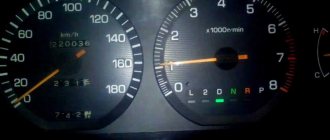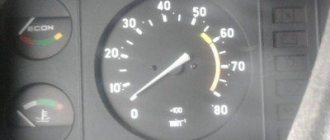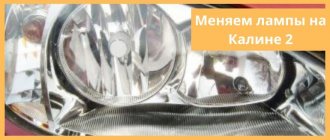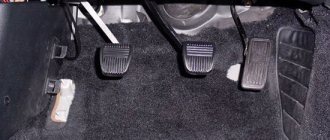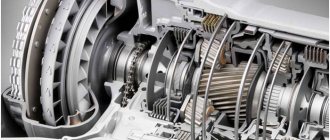Problems with engaging first gear when starting a car are most often caused by damage to the clutch or synchronizer . But also sometimes the first gear does not engage well due to wear on the engine mounts, an incorrectly configured shift mechanism (rocker), a breakdown of the internal switch, and even malfunctions of the chassis.
Let's look at all the main causes of such breakdowns in different situations: when starting, on a cold and on a warm gearbox, and we'll figure out how to engage first gear without harming the gearbox.
This article will help you figure out why the gearbox shifts slowly, the first gear is difficult to engage, or, conversely, the gearbox is stuck in 1st gear.
Poor activation due to the slider
First, let's look at why first gear doesn't engage well and the problem is with the transmission.
Often the problem with turning on the speed lies in the latch and slider. The appearance of a burr near the groove for the retainer on the slide can easily prevent the ball retainer from entering the groove. When moving the slider, the latch rests on this burr and cannot overcome it without significant effort from the driver. In this case, the gears come very close to each other, but do not engage, and the teeth of one gear hit the other.
In the future, such beating can lead to flaring of the teeth, and the impossibility of engagement will be due to the fact that due to this flaring, the teeth will no longer be able to engage.
For those with automatic
If your car has an automatic transmission. It will not hurt you to know the modes in which your machine can operate:
- P – For parking and starting the engine. Switching to this mode is possible only after the machine has completely stopped.
- R – To move backwards. Switching to this mode is also possible only after stopping the car and with the brake pedal pressed.
- N – Neutral. When the engine is completely disconnected from the gearbox.
- D – Moving forward without restrictions on gear shifting (the most commonly used operating mode of the automatic transmission).
- D3(S) – Low gears for climbing and braking engines on descents.
- D2 – Mode for difficult conditions (slippery or mountainous roads). Gears above second are not shifted, that is, only first and second gears are engaged.
- D1(L) - Movement occurs only in 1st gear, used off-road on mud, snow or ice, where you need to drive without changing the throttle, and also to overcome steep climbs.
The automatic transmission also has a button on the mode shift lever with the inscription O/D OFF. When it is turned on, the inclusion is prohibited, increasing the gears of the analogue of the 5th gear of the manual transmission. That is, if your automatic machine has 4 gears for moving forward, then for more dynamic acceleration it will use only three lower gears.
About a faulty automatic transmission, an automatic transmission is much more complex than those encountered with a manual transmission, and the chances of repairing it in your garage are slim. But despite this, you still need to know something about it, if only in order not to harm it through improper use.
An automatic transmission is much more demanding in terms of accuracy in maintaining the oil level in it than a manual transmission. Both too low and too high oil levels are very harmful to her. Both of these can lead to serious damage. In both cases, oil foaming occurs. When there is a lack of oil due to the fact that the oil pump begins to capture air along with the oil. When there is excess oil, it foams on the rotating parts, which in this case are immersed in it. Foamed oil compresses better and has low thermal conductivity. Therefore, if you operate a machine with such oil, the pressure in its control systems will be low. Which will lead to slipping of the clutches and their intensive wear. Deteriorated thermal conductivity will not allow all excess heat to be removed. Which, together with low pressure, will lead to the machine failing and requiring serious repairs.
Reasons for complete jamming
There are not so many reasons for a complete jamming of the gearbox. One of these reasons is the destruction of the teeth of a gear. Broken tooth fragments can become meshed with the teeth of other gears, which in turn makes the gears unable to rotate.
It is also possible that one of the internal bolts of the box may rupture or spontaneously unscrew. In this case, the bolt gets between the gears and blocks them.
To check whether the cause of jamming is the destruction that occurred inside the box, simply drain the oil from the box crankcase and check it. The fact is that if any element of the box is destroyed, a large amount of metal shavings will get into the oil.
Knocks out the first gear of the VAZ 2110 reasons
VAZ 2110 gearbox malfunctions
- January 11, 2009
The VAZ 2110 has been produced for several years now, because all the “sores” of these cars have long been known, both to ordinary owners of “ten” cars and to VAZ itself. The latter seems to be trying to gradually solve these problems, but very gradually. But that's a completely different story, as they say.
In addition to the diseases themselves, their symptoms are also known. In this article we will provide a list of the main possible malfunctions of the VAZ 2110 gearbox and the symptoms by which you can at least roughly identify the problem without disassembling the gearbox.
Noise in the gearbox.
Increased noise during gearbox operation can be caused by the following reasons:
- wear of gear teeth - wear of bearings - insufficient oil level in the box
Reverse gear does not engage on a viburnum - how to solve the problem yourself?
Drivers can diagnose many problems with reverse gear on Lada Kalina and then fix them with minimal time losses with their own hands.
To do this, it is not at all necessary to contact a car service center and pay money for the services of specialists. If the reverse gear on Kalina, beloved by domestic motorists, does not engage, there is no need to immediately go to the technical center. Usually such a problem is solved in a couple of hours in a private garage. Often the reason for the incorrect behavior of the iron horse of the brand we are interested in is a faulty electrical wiring in the gearbox (gearbox).
On Kalina, reverse gear is started by retracting the gearshift lever and locking it in first gear. After performing these actions, the solenoid in the box is activated.
Its task is to redistribute the gears so that they effectively transfer the load when rotating against their axis (that is, to ensure driving at reverse speed).
If, after an independent examination, it suddenly turns out that the malfunction is due to the electrical wiring in the gearbox, then there is a chance to solve the problem without resorting to the help of a qualified service
In fact, the car, working in first gear, moves in reverse due to a special additional gear connected to the mechanism of the levers. This simple circuit stops functioning in cases where the wires in the specified solenoid become rotten. This problem can be solved simply:
- Turn the front left wheel all the way (to the side).
- Raise the hood.
- Using a 36 key, release the special washer that tightens the solenoid housing. We carefully dismantle it.
- Blue and yellow wires come out of the housing. They may be responsible for the fact that the reverse gear does not work.
- If we see that the wiring is rotten or covered with a thick layer of moisture and oil, we change them.
- Reinstall the solenoid housing.
- We start the Lada Kalina, drive 20–30 meters in first gear, and engage reverse.
The entire procedure described takes approximately 40–50 minutes. But sometimes the actions taken do not solve the problem. Then it makes sense to check the operation of the switch button.
The wires leading to it also rot quite often. We remove the rubber gasket and the lever itself right in the cabin. We inspect the switch for faulty wiring.
If there is one, we replace the damaged wiring.
After dismantling the lever, be sure to inspect it for signs of corrosion. Very often, ingrained rust stops the switch button, preventing you from engaging reverse. We remove the corrosion, put the lever and gasket back. Let's try the back one. If after this it does not work, we look for other reasons causing the malfunction.
Let's consider other common reasons that do not allow the use of reverse gear on regular and tuned LADA Kalina 1 and LADA Kalina 2. The reed switch may have flown. The functionality of this element is easy to check.
We dismantle the decorative casing above the lever in the car interior and look for its connector. We remove the last one and close the contacts.
This operation can be performed using a piece of wire, a paper clip, or any other suitable device at hand.
After mechanically closing the wiring, we try to turn on the reverse gear. If the problem is solved, leave everything as is. We're going about our business. And at the first opportunity we go to a car service and completely change the reed switch.
It is impossible to operate a car with the wiring connected according to the specified diagram for a long time.
Note that failure of the reed switch is most often caused by rotting of its contacts or the entry of small particles of dirt and debris into the mechanism.
It is impossible to predict the complexity of a breakdown in advance based on sensations alone, so you should not make hasty conclusions
If the reverse gear is engaged, but the driver does not hear the characteristic sound with which the additional gear comes into operation, we can safely say that the release bearing is faulty.
It usually breaks due to metal filings or waste oil that has penetrated the gearbox mechanism. These pollutants increase the friction force. This causes rapid wear of the bearing, and in some cases leads to combustion of the entire mechanism.
The described problem can be solved in one way - you need to install a new bearing.
We have already told you how to replace the wires leading to the solenoid. Now let's look at the rules for repairing the Kalina locking mechanism. Its malfunction makes it impossible to turn on the rear. To perform this type of repair, you need to look at the solenoid control circuit. It is given below.
Failure of the mechanism in most cases is caused by the failure of fuse F21 (it is rated at 10 A). Through it, as can be seen in the diagram, 12 V is supplied to L1 (solenoid). Then S1 (switch) closes the circuit to ground. As a result of this, the solenoid coil is activated.
If the fuse is blown or the switch is faulty, reverse gear will be locked. Let's solve this problem. We take out the fuse (if you look at the left, it will be the eighth one), and check it with a multimeter. Instead of the faulty element, we install a new one (of strictly the same rating - 10 A).
New Lada: Airbag malfunction icon is on, how to reset the error?
When F21 starts working, we work on the switch (see the first section of the article).
If replacing the switch and fuse does not produce results, remove the connector from the solenoid. We put regular pins in it (two pieces). We measure the voltage with a multimeter.
With a normally operating mechanism, it is equal to 12 V. If the readings are different, we have a break in the electrical harness on the pallet - at the place where the clamp is mounted. We pull out the entire harness, expose the wires, and eliminate the break.
We solder the twisting area and treat it with heat shrink for greater reliability.
In very rare cases, the solenoid itself breaks down. You can check if it is faulty with a multimeter. We connect the device to the solenoid and measure the resistance. If we see a value other than 2.2 Ohm, we will have to change the element. The work is not difficult, but quite dirty.
You will need to drain the oil from the gearbox, then remove the old solenoid and install a new one. Before installing a working element, be sure to treat the threads with sealant. It is important. Without this procedure, oil will soon begin to seep through the threads.
If the described methods for restoring the normal functioning of the gearbox did not help, most likely we encountered problems in the mechanical part of the gearbox:
- the spring burst;
- the retaining bolt has been cut off;
- The device that secures the gearbox elements has broken.
These faults are truly complex. Such problems must be solved by car service specialists, since they will need to remove the gearbox, disassemble it, find the cause of the breakdown, and then fix the problem. All this takes more than one hour and requires the use of special tools. It is irrational to carry out such repairs at home.
Repair work
If the adjustment does not give the desired result, you will have to work more carefully with the box. A common problem is knocking out the gears responsible for speeds 1 and 2.
When dismantling, make sure that each individual fastener is in good working order. The latches are springs, of which there are a total of three. The first one is the longest, it is responsible for speeds 1 and 2. The second is medium in size, and its prerogative is 3 and 4 speeds. The third detent is the smallest, and its “guardian” is fifth gear.
Clutch basket
Over time, the clutch basket fails on all cars with a manual transmission. Sometimes it’s due to wear and tear, sometimes the petals or the so-called “spider” break. Let me start, perhaps, with the “spider”, this is a mechanically fixed release bearing on several extensions (done like this on some VAZs), if the extension breaks, then it cannot be effectively fixed to the basket - the gears do not engage.
Next, the petals of the box break, or they become weakened. This leads to the fact that it is very difficult, almost impossible, to release the clutch disc. Therefore, the “speeds” do not switch – we just change the basket.
Well, the last wear and tear is the basket disk. It has a metal disk inside, and over time, especially from high mileage, wear forms there. When starting, the car will shake, and if the wear is very large, the gears may not shift.
In any case, we need to change the clutch basket.
Synchronizers
If, when the engine is running, you do not engage gears, or shifts occur with VERY great effort and CRUNCHING! Then there may be a problem with the manual transmission synchronizers. Without going too deep, these are soft gears (usually brass or copper) that synchronize the shafts for soft and fast shifting. If they wear out, then shifting may disappear altogether! In general, we are definitely changing.
How does a manual transmission work?
A conventional manual gearbox consists of 3 shafts. These are the primary, intermediate and secondary shafts. The secondary shaft is located coaxially with the primary shaft, inside which there is a bearing into which the end of the secondary shaft fits, allowing it to rotate independently of the primary.
The intermediate shaft is a single unit with gears cast on it. It has a rigid connection through a gear to the input shaft, which causes it to rotate along with the gears of the gears.
Adjusting the gearbox, video instructions
If it is necessary to replace gears, bearings or other parts, the box must be dismantled. Usually in such cases, the VAZ 2110 gearbox is overhauled and elements that have failed are replaced. But removing the box is not always necessary.
It is known that the 10 has problems with gear shifting. In fact, the speed is knocked out.
To eliminate the problem, the unit is equipped with a special mechanism that allows you to adjust the drive.
The operation is performed in the following cases:
- the gearbox was dismantled due to repairs, for example, replacing the input shaft bearings;
- speed knocks out while driving;
- Gears don't engage or disengage easily.
If such situations arise, then adjustments cannot be avoided.
Of course, performing this procedure is much simpler than dismantling work. The work is performed in the following sequence:
- At the bottom of the vehicle there is a nut in a bolt. This fastener holds the transmission linkage in place. The fastening element does not need to be removed: just unscrew the nut a little;
- to move the grooves of the rod and the slot of the fastening clamp apart, just use a flat screwdriver;
- the rod must be set to the neutral position. Then you need to remove the cover from the gearbox handle;
- then the lever is set in accordance with the template;
- at the next stage it is necessary to adjust the backlash of the rear vector rod;
- adjusting axial play;
- At the final stage, the fastening must be installed in place and tightened.
If you have a mechanic
Gears shift poorly in a car with a manual transmission for three reasons. The first of these is a malfunction of the clutch when it does not completely disengage (drive). The first sign of this malfunction is that the reverse gear is engaged with a characteristic crash. The rear one reacts to this anomaly more noticeably than other gears, because it is the only one not equipped with a synchronizer.
The second reason is a defect in the gear selection mechanism of the gearbox. And finally, the third is excessive wear of the gearbox synchronizers.
There are also several clutch malfunctions in which manual transmission gears shift poorly:
- Air in the clutch release hydraulic drive or fluid leakage from it. The malfunction is eliminated by replacing failed components of the hydraulic system and pumping it.
- Worn or broken clutch release fork. The part requires replacement or repair.
- Warping (runout greater than 0.5 mm) or too thick new driven disk.
- Failure of the basket (temperature deformation of the pressure plate or its distortion).
- Loss of mobility of the support bearing of the gearbox input shaft (at the end of the crankshaft to which the flywheel is attached).
- Jamming of the clutch driven disc hub on the splines of the gearbox input shaft. To eliminate the defect, clean the splines of the gearbox hub and input shaft. It wouldn’t hurt to lubricate them a little with lithol.
There is too much free play in the clutch release fork. Its value needs to be clarified with the manufacturer, since it is slightly different for different cars. Until you find out the value of this parameter for your car, set it from 5 to 8 mm. Too little free play of the fork is also undesirable, as it leads to clutch slipping and increased wear of the release bearing.
Excessive wear of synchronizers mainly occurs in those gears that are engaged more often: these are usually first, second and third. The rear one is not included in this list because it does not have a synchronizer. When your gear shifts poorly, and you assume that the reason for this is wear of the synchronizers, firstly, you should only have difficulties with this while driving. Secondly, in this case it switches better if you use double squeeze.
For those who don’t know what double squeeze is. To shift to a higher gear: depress the clutch, engage neutral, release and depress the clutch again, engage the gear.
Backlash in the so-called “helicopter” is one of the reasons for unclear gear shifting
To switch to a lower gear: double squeezing must be combined with re-engaging, that is, when the clutch pedal is released and the gearbox is in neutral, you need to press and release the accelerator pedal. This is how gears are changed in cars that do not have synchronizers. If the gearbox shifts easier using double squeezing, then the culprit for poor gear shifting is most likely worn synchronizers.
If the gears shift poorly when the car is standing still with the engine turned off, the fault may only be in the gear selection mechanism of the gearbox.
Look for damage or check that it is adjusted correctly. Don't even think about the clutch and synchronizers.
Knocking out the speed
If it turns on, but immediately turns off, then the latch may be stuck in the squeezed position, so it no longer does its job. It is also possible that the spring that presses the ball retainer is destroyed. Without the force of the spring, it will not be able to hold the slider in the desired position.
If significant force is applied while shifting into gear, the shift fork may bend.
Poor switching may also be caused by incorrect installation of the gearshift knob. In this case, the rocker does not bring the gear to full engagement.


